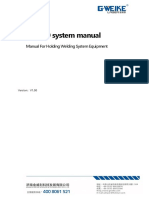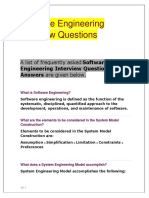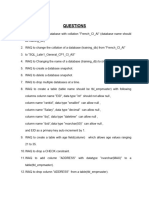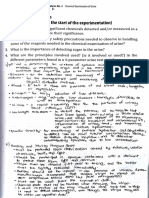OOSE IAT 3 ANS
Uploaded by
Priyashree HaridossOOSE IAT 3 ANS
Uploaded by
Priyashree Haridoss1. What is Agility?
1. Flexibility in Process: Agility refers to the ability to adapt and respond to changes quickly
and efficiently in the software development process.
2. Incremental Development: It emphasizes iterative progress through small, manageable
increments.
3. Customer Collaboration: Agility involves continuous collaboration with customers to
ensure the final product meets their needs.
4. Continuous Improvement: Agile practices encourage constant feedback and improvement
throughout the development cycle.
2. Define the Role of Software Engineer
1. Requirement Analysis: A software engineer analyzes user requirements to determine the
feasibility of design within time and cost constraints.
2. Design and Development: They design, develop, test, and maintain software systems or
applications to solve problems or fulfill specific needs.
3. Problem Solving: Software engineers troubleshoot, debug, and upgrade existing systems.
4. Collaboration: They work closely with other team members, including developers, project
managers, and stakeholders, to ensure the successful delivery of software projects.
3. How Does Data Flow Diagram Help in Design of Software System?
1. Visual Representation: Data flow diagrams (DFDs) provide a visual representation of the
flow of information within a system.
2. Clear Communication: They help in communicating system processes and data handling
to stakeholders and team members.
3. Identifying Data Sources: DFDs identify the sources, destinations, and storage of data,
making it easier to understand system requirements.
4. Process Simplification: They break down complex processes into simpler, more
manageable parts, aiding in the design and implementation phases.
4. Collaboration Diagram for ATM
5. Guidelines for Modular Design
1. High Cohesion: Each module should perform a single, well-defined task.
2. Low Coupling: Modules should be as independent as possible, minimizing dependencies
between them.
3. Information Hiding: Internal details of modules should be hidden from other modules.
4. Reusability: Modules should be designed to be reusable in different parts of the system or
in different projects.
6. What is an Architectural Style?
1. Design Pattern: An architectural style is a reusable solution to a common problem in
software architecture.
2. Structure Definition: It defines the structure and organization of software systems.
3. Communication Rules: Specifies how components interact and communicate within the
system.
4. Examples: Common architectural styles include Client-Server, Layered, Microservices,
and Event-Driven architecture.
7. Steps Involved in Testing Real-Time Systems
1. Requirement Analysis: Understanding real-time constraints and performance
requirements.
2. Test Planning: Creating a test plan that includes timing and synchronization aspects.
3. Test Case Design: Developing test cases that cover normal and edge cases with specific
timing constraints.
4. Execution and Monitoring: Running tests and monitoring system behavior to ensure it
meets real-time requirements.
8. What is Meant by Smoke Testing?
1. Initial Testing: Smoke testing is a preliminary testing process to check the basic
functionality of a software build.
2. Build Verification: It ensures that the critical features of the application are working.
3. Early Detection: Helps in identifying major issues early in the development cycle.
4. Basic Functionality: Focuses on verifying that the most essential functions perform
correctly without detailed testing.
9. What is Software Configuration Management?
1. Version Control: Managing changes to software artifacts like code, documents, and
configurations.
2. Tracking Changes: Keeping track of who made what changes and when.
3. Baseline Management: Establishing baselines to manage and control software versions.
4. Build Management: Ensuring the correct and consistent creation of software builds.
10. How is DevOps Different from Agile Methodology?
1. Scope: Agile focuses on iterative development and customer feedback, while DevOps
encompasses the entire software lifecycle, including development, deployment, and
operations.
2. Collaboration: DevOps promotes closer collaboration between development and
operations teams, whereas Agile primarily involves development and business teams.
3. Automation: DevOps emphasizes automation of the deployment pipeline, while Agile
focuses on iterative progress and flexibility.
4. Continuous Delivery: DevOps aims for continuous delivery and deployment, ensuring
software is always in a deployable state, while Agile focuses on continuous improvement
and incremental delivery.
11 A Explain any two prescriptive process models in detail
Prespective models assgn.pdf (or) OOSE U1.pdf pg no 12
12 A Explain Functional and Non Functional Requirement in detail.
SE 1.pdf pg no 26 (OR) SE 4.pdf pg no 26
13 B Explain in detail about Flow-oriented Modeling and Behavioral Modeling
13 B ans
14 A Explain about Object oriented testing strategies in details
14 ANS
15 A Explain the functionality of Software Project Management 15 ans
16 B What is Deployment pipeline? Explain the overall Architecture building and testing?
OOSE TECH.pdf pg no 438
You might also like
- Chapter 5 - Architecture in The Life CycleNo ratings yetChapter 5 - Architecture in The Life Cycle26 pages
- 1. Software Development Life Cycle (SDLC)No ratings yet1. Software Development Life Cycle (SDLC)17 pages
- 35. Purpose of Modeling in Software EngineeringNo ratings yet35. Purpose of Modeling in Software Engineering6 pages
- Types of Software Engineering PracticesNo ratings yetTypes of Software Engineering Practices25 pages
- Interview Questions Software EngineeringNo ratings yetInterview Questions Software Engineering11 pages
- Software Testing Interview Questions You'll Most Likely Be AskedFrom EverandSoftware Testing Interview Questions You'll Most Likely Be AskedNo ratings yet
- 20NE204 Advanced Software Engineering key-updatedNo ratings yet20NE204 Advanced Software Engineering key-updated6 pages
- Software Architecture For Developers SampleNo ratings yetSoftware Architecture For Developers Sample93 pages
- Financial Planning Principles - The Pritchett - Financial Statements and RatiosNo ratings yetFinancial Planning Principles - The Pritchett - Financial Statements and Ratios5 pages
- Altermodernity: A Postcolonial(s) Constellation50% (2)Altermodernity: A Postcolonial(s) Constellation10 pages
- Chasing Cars Tab by Snow Patrol Songsterr Tabs with RhythmNo ratings yetChasing Cars Tab by Snow Patrol Songsterr Tabs with Rhythm1 page
- Maria, or The Wrongs of Woman by Wollstonecraft, Mary, 1759-1797No ratings yetMaria, or The Wrongs of Woman by Wollstonecraft, Mary, 1759-179774 pages
- Trying to Grow by Firdaus Kanga-190-247No ratings yetTrying to Grow by Firdaus Kanga-190-24758 pages
- Introduction To Physical Agent and Electrotherapy: Dr. Sadia Rasheed IIRS, HyderabadNo ratings yetIntroduction To Physical Agent and Electrotherapy: Dr. Sadia Rasheed IIRS, Hyderabad23 pages
- Bryostatin-1 Alleviates Experimental Multiple SclerosisNo ratings yetBryostatin-1 Alleviates Experimental Multiple Sclerosis6 pages
- Presented by - R Hemamalini 2010CYZ8795 Group G1100% (1)Presented by - R Hemamalini 2010CYZ8795 Group G129 pages
- Fast Radial Basis Functions for Engineering Applications Marco Evangelos Biancolini all chapter instant download100% (2)Fast Radial Basis Functions for Engineering Applications Marco Evangelos Biancolini all chapter instant download40 pages
- LM567/LM567C Tone Decoder: Features ApplicationsNo ratings yetLM567/LM567C Tone Decoder: Features Applications17 pages































































































